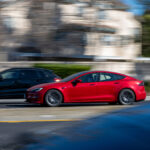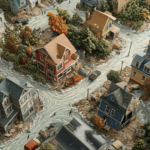A helicopter’s crash landing in South Carolina this week may have been triggered by a civilian drone, which would make it the first drone-related crash of an aircraft in the U.S.
The incident on Wednesday involved a student pilot and an instructor, both of whom told investigators that a small drone appeared directly in front of them, according to a Charleston Police Department report. The instructor took over the controls and attempted to avoid a collision, and the tail of the helicopter hit a tree or brush, triggering a crash landing.
The National Transportation Safety Board announced Friday it is opening an investigation into the crash, spokesman Chris O’Neil said. “The NTSB is aware of the pilot’s report that he was maneuvering to avoid a drone, but the NTSB has not yet been able to independently verify that information,” O’Neil said in a statement.
Neither the pilot nor the student was injured, though the helicopter’s tail appeared to have significant damage, said a person familiar with the incident, who wasn’t authorized to discuss the inquiry publicly.
The Robinson Helicopter Co. R22 went down about 2 p.m., according to a statement by the Federal Aviation Administration. The FAA didn’t confirm the possible role of the drone.
The accident investigation is the second incident involving a drone in less than a week and comes as aviation groups are demanding tighter regulations on civilian drone use following reports of other possible near collisions involving the devices.
In the U.S., drones are typically restricted to flights within 400 feet of the ground and within sight of the operator. They also are supposed to stay clear of traditional aircraft. But in the thousands of FAA reports of possible drone safety incidents, many involved apparent illegal flights.
In the Charleston incident, the student was practicing low-altitude hovering in a remote area, according to the police report. As she turned the aircraft around to continue the lesson, a small white drone appeared, the instructor told police.
The instructor took the controls and after maneuvering away from the drone, the copter’s tail hit brush or a tree as he attempted to land. The helicopter then fell on its side.
The four-rotor drone appeared to be a model group known as the Phantom, manufactured by SZ DJI Technology Co. of China and one of the most popular in the world, he told police. The drone and its operator weren’t located.
Drone Maker
“DJI is trying to learn more about this incident and stands ready to assist investigators,” the company said in a statement. “While we cannot comment on what may have happened here, DJI is the industry leader in developing educational and technological solutions to help drone pilots steer clear of traditional aircraft.”
An NTSB investigator is interviewing the two people aboard the helicopter and will gather other information from possible witnesses and other sources, O’Neil said.
Authorities in Canada released a report Wednesday on a collision there involving a drone and a small charter plane. The FAA said earlier this week it was trying to confirm whether an air-tour helicopter in Hawaii clipped a drone. The incidents come just days after leading aviation-industry groups urged Congress to tighten regulations on hobbyist drones because of a video apparently showing one flying feet from an airliner near Las Vegas.
The use of drones near airports and “within controlled airspace poses a serious risk to aviation safety,” Canada’s Transportation Safety Board said in the report. “For this reason, all recreational and non-recreational drone users must be knowledgeable about and comply with the regulations, including the requirement to operate within line of sight.”
The FAA in a study based on computerized models last fall concluded that drones would cause more damage than birds of similar size because they contain metal parts. Significant damage to windshields, wings and tail surfaces of aircraft was possible, the study found.
The surging number of episodes combined with a regulatory system that makes it difficult to monitor drone flights has alarmed traditional aviation groups.
The likelihood that a drone will collide with an airline aircraft is increasing,” said a letter to U.S. lawmakers earlier this week from Airlines for America, a trade group representing large carriers, and the Air Line Pilots Association and the National Air Traffic Controllers Association, the unions that represent pilots and controllers.
The Hawaii incident occurred Feb. 9 over the island of Kauai, according to the FAA. The pilot reported seeing the drone that hit the helicopter and scratches were found on the copter afterward. There was no significant damage and no one was injured, according to the FAA.
The only confirmed drone-related aviation accident in the U.S. occurred on Sept. 21 above New York City. A drone struck an Army helicopter near Staten Island, according to the NTSB. The helicopter landed safely. The drone’s operator had flown the device out of his sight and didn’t see the helicopter, the NTSB found.
Confirming whether a drone was involved in such cases has been difficult. In the New York case, a piece of a drone was found lodged in the helicopter and its part number was used to trace it back to the owner.
Quebec Incident
A small drone that struck a charter plane carrying eight people above Quebec City highlights the need for people to follow legal restrictions, an investigation by the Transportation Safety Board of Canada concluded.
The TSB couldn’t find debris from the drone or track down its operator after the Oct. 12 collision. It called on operators of the devices to better educate themselves on the rules and safety hazards. The plane, a twin-turboprop, was able to land safely with only minor damage to its left wing, the report found.
Even groups that have traditionally defended the rights of hobbyists to fly drones have been raising increasing alarm.
The Academy of Model Aeronautics, which represents hobbyists who fly at clubs around the country, issued a statement Tuesday saying “some rogue flyers choose to operate in an unsafe manner despite existing drone laws.”
It called on the FAA and local police to “hold these people accountable.”
Was this article valuable?
Here are more articles you may enjoy.

 Citigroup Sued by More Ex-Sales Traders Over 2019 HK Firing
Citigroup Sued by More Ex-Sales Traders Over 2019 HK Firing  Tesla a Step Closer to Ride-Hailing With California Permit
Tesla a Step Closer to Ride-Hailing With California Permit  Verisk: Claims Volume Rose 36% in 2024, Largely on Catastrophe Claims
Verisk: Claims Volume Rose 36% in 2024, Largely on Catastrophe Claims  Bayer Weighs Billions in Capital Raise for Lawsuits, Shares Tumble
Bayer Weighs Billions in Capital Raise for Lawsuits, Shares Tumble 